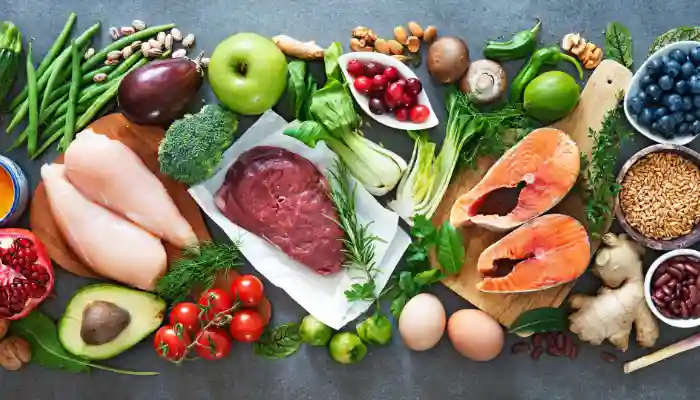Paleo, Whole30, carnivore diet, intermittent fasting — these are just some of the terms around diets and nutrition that have become popular over the last few years.
It can seem hard to keep up with current advice and even harder to decide what you might apply to your own diet. But when you look at the U.S. Dietary Guidelines first presented in the 1950s compared to now, they’ve basically stayed the same: balance your calories and limit foods high in sodium and sugar.
With that in mind, we’re diving into popular nutrition myths you can ignore — and you’ll likely find that they open up more eating possibilities than you imagined.
Get the Facts: 5 Myths About Nutrition
1. Fresh fruits and vegetables are nutritionally superior to frozen
It’s true that nothing can compare to a summertime tomato or blackberries ripe from the farmer’s market. However, don’t limit yourself to the fresh produce section at the market when it comes to nutrition.
Unless they’re local or homegrown, many foods we eat have traveled long distances to reach store shelves. For instance, a container of fresh blueberries may have been picked days or weeks ago, shipped in cold storage, held at a distributor or the store, and then set out for purchase.
Compare that with frozen blueberries, which are typically picked, cleaned, and frozen quickly. That means that nutrients and freshness have been “locked in” — perhaps more so than with the fresh option. Buying fresh produce when it's not in season can also mean ingesting fewer nutrients.
Still, it’s wise to check labels before purchasing — some products may have added ingredients or sauces that can include sodium or sugar.
2. Low-carb diets are healthier
Many people consider popular low-carb diets like Keto healthy because they promote rapid weight loss and improve certain health markers. By drastically reducing carbohydrate intake and increasing fat consumption, the body enters a state of ketosis, burning fat for fuel instead of glucose.
However, experts caution against potential negative outcomes, such as weight regain, excessive saturated fat intake, increasing heart disease risk, and nutrient deficiencies. Moreover, the diet restricts foods like fresh fruits, vegetables, whole grains, and low-fat dairy, which are essential for long-term health. Consequently, it's not universally recommended due to its restrictive nature and potential for adverse effects
“The bottom line is, reducing simple carbohydrates like white bread or pasta and replacing them with complex carbohydrates is a good choice,” said Alaina Hoschke, Registered Dietitian of 305 West End Assisted Living. “However, for most people, completely cutting all carbs is unnecessary and may do more harm than good in the long term.”
Related: Simple Mediterranean diet recipes you can prepare at home >>
3. All fats should be avoided
For many years, the message that “all fats are unhealthy” meant consumers avoided healthful options like olive oil and nuts. Low-fat substitutes meant that most people replaced the calories they would have consumed from fat with simple carbohydrates.
In reality, fat is an essential part of our diet. They help fill us up and promote feelings of satisfaction after eating. They also have little to no effect on blood sugar levels.
Still, it’s important to distinguish between different types of fat. Unsaturated fats are found in foods like olives, nuts, and flaxseed.
“You can boost your intake of heart-healthy fats by choosing foods like avocados, walnuts, and salmon,” said Hoschke. “Foods like these are also commonly found on the menu here at 305 West End.”
Saturated fats, on the other hand, are found in whole-milk dairy products and red meat. When consumed in large amounts over time, they can lead to cardiovascular problems. Trans fats, sometimes found in shelf-stable snack products, also offer no nutritional value.
4. Food labels that say things like “Natural” and “Wheat” are always healthier options
Unfortunately, seeing isn’t always believing when it comes to food packaging. For example, the word “Natural” may lead consumers to believe that a product is healthy, doesn’t contain artificial ingredients, or perhaps isn’t made with genetically modified ingredients.
However, this term isn’t regulated by the USDA or FDA, so it may have little real meaning when it comes to the product's nutrition.
Another potentially misleading label claim is the term “wheat.” While this sounds like a healthier option, it doesn’t mean the product contains nutritious whole grains.
“A simpler way to ensure the healthfulness of the product you buy is to look at the ingredients list. While you may not recognize every ingredient, you can prioritize eating single-ingredient foods and foods with a short list of ingredients that specifically mention whole wheat or whole grain as the first ingredient,” said Hoschke.
“Another technique is to shop the perimeter, meaning to prioritize buying the fruits, vegetables, proteins, and grains that are found more often around the perimeter, not within the aisles, of the grocery store.”
5. Eating a healthy diet is expensive
Eating well doesn't necessarily have to be more expensive. Planning, purchasing whole foods in bulk, and cooking at home can significantly reduce costs compared to buying specialty health foods.
On the other hand, while seemingly convenient, regular consumption of processed foods or frequent dining out can also accumulate high costs over time. While processed foods might have lower initial prices, nutritional deficiencies and related health issues can lead to higher health care expenses. Thus, a healthy diet can be affordable and beneficial with thoughtful choices.
“Some of the healthiest foods you can eat — like cabbage, sweet potatoes, brown rice, and lentils — are also some of the most inexpensive,” said Hoschke. “There’s no need to break the bank at the market to enjoy a healthy, varied diet.”
Healthy Eating Options at 305 West End Assisted Living
Residents benefit from three delicious and nutritionally planned daily meals served in our country club dining room or bistro grille. A juice bar is also available for healthy smoothies, light snacks, juices, and other specialty drinks.
The 305 West End culinary team strives to get to know each resident’s tastes and preferences so they can deliver excellent service. It’s not uncommon for staff to remember what beverages residents prefer, how they like their eggs prepared, and which desserts are their favorites.







